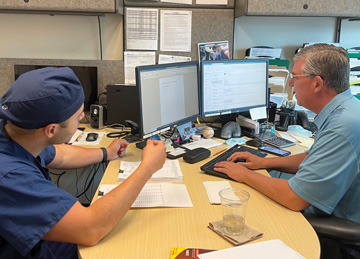Kim Merrill, BSN, RN, nurse administrator at Harford County Ambulatory Surgery Center in Edgewood, Md., has been with her facility for 23 years, the last 17 as the administrator. The center focuses mainly on workers’ comp and attorney
cases. “We used to have anesthesia providers on staff,” she says. “Billing for their services became difficult to manage, so we went with an outside anesthesia group.”
Her ASC was not exceptionally busy to begin with, but it’s even less so now with an ENT surgeon who performed a few dozen cases per month retiring and the pandemic wreaking havoc with scheduling. The center’s combined lack of volume
— on average, 1,400 cases per year — and scheduling uncertainty has made it more difficult for Ms. Merrill to make her anesthesia numbers work.
She understands that cost certainty for anesthesia groups is a legitimate concern. “Because we don’t have high surgical volume, they want to charge a stipend,” she says, describing a flat rate that applies no matter how many
surgeries are performed in a day or month.
That doesn’t mean stipends make good financial sense for the facilities that pay them. “We did only 45 cases during the month of December because of COVID, but still paid a $7,000 stipend to the anesthesia group,” she says.
“Do the math.”
The numbers don’t add up. Ms. Merrill has consolidated her schedule, decreasing monthly days of surgery for increased efficiency, and shut down one of the facility’s two ORs. One benefit of that strategy is not needing to pay a
daily stipend for days with no surgeries. However, last-minute cancellations muck up the works. “No matter what the reason is, if it’s less than two weeks in advance, I pay the stipend for that day — a daily rate per
room.”
Despite all of that, Ms. Merrill is still happy with her local, independent anesthesia provider. “We have something good here,” she says. “I don’t worry about the quality and safety of the care my patients receive and
the group’s individual providers are amazing. To me, anesthesia care is about quality. I have no interest in changing providers, but we’re taking a huge hit because of the stipends before a patient even walks in the door.”
Arizona Anesthesia Solutions in Phoenix partners with 150 providers across three markets and has seen many competing groups in Arizona purchased by larger anesthesia management companies. “That’s what’s happening in anesthesia
right now,” says managing partner Joseph Rodriguez, CRNA, who has spent much of the past five years helping to lead Tri-City Surgery Center in Prescott. “I’m very familiar with the dynamics because I speak ASC.”
It’s tough to run these organizations well, so it’s not surprising we’re seeing a lot of consolidation.
— Joseph Rodriguez, CRNA
Dr. Rodriguez describes the situation as a twofold problem: Anesthesia groups are short-staffed and they’re using antiquated or restrictive models of care. He advocates for full utilization of MDs and CRNAs to expand coverage, particularly
at outpatient facilities.
ASCs are at a disadvantage because hospitals can afford to subsidize anesthesia services, while most ASCs can’t. “That’s the problem in a nutshell, and it’s not going away quickly,” says Dr. Rodriquez. “Based
on information I’m receiving, this issue will impact anesthesia care for the next two to five years.”
It’s difficult sledding for small independent anesthesia groups because of evaporating margins and other economic factors, according to Dr. Rodriquez, who points out Medicare reimbursements are extremely low and it’s difficult
to negotiate with large private payers. “It’s tough to run these organizations well, so it’s not surprising we’re seeing a lot of consolidation,” he says.
Clinicians running small- and medium-sized anesthesia groups are getting courted by larger companies that offer the latest tools and technologies, capital, professional management, negotiating power with payers and the promise of steadier
income with fewer headaches — essentially more reliability with less flexibility, which is what separates nimble local groups from the national competition.
Many national groups lack the interest or ability to cover last minute add-on cases, according to Dr. Rodriguez. “The local shops are going to be a little more flexible, a little more relationship-oriented,” he says.
There’s also a downside to doing business at the national level. “Big anesthesia groups naturally demand a larger margin to make their business work,” says Dr. Rodriguez. “They might adjust that down given specific
circumstances, but they’re a business just like a surgery center, and they need to make a profit.”
He believes ASCs must make every operating day as efficient as possible while adjusting their payer mix to withstand the anesthesia shortage. “Surgery centers are beginning to use algorithms to predict scheduling and immediately get
feedback in terms of the revenue a case will generate and if it will cover costs,” he says.
Dr. Rodriguez is quick to point out that not every anesthesia provider or group wants out of the surgery center space and suggests surgical leaders strive to find a staffing model that works for the specific needs of their centers. “You
need the right personnel, compensation and culture,” he says. “Evaluate those three things, and you’ll come up with a good design.”
There is another option. “What’s preventing a surgery center from hiring their own providers and taking it in house?” says Dr. Rodriguez. “They’ll face the same cost constraints, negotiations with private payers,
and challenges related to staff recruitment and retention, but in the long run, because anesthesia can become a cost center, most centers conclude it’s better to run their business well enough where if they do need to subsidize anesthesia,
they can do it and get that service in place.”
.svg?sfvrsn=be606e78_3)

.svg?sfvrsn=56b2f850_5)